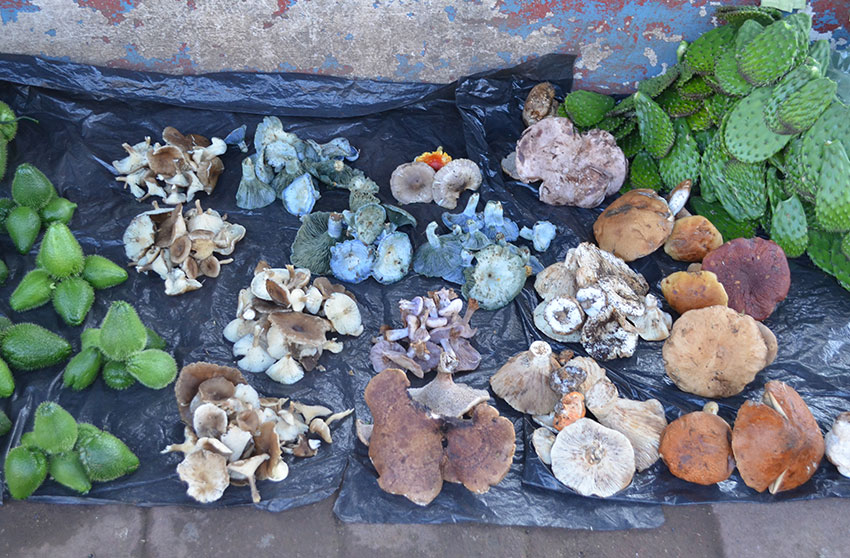The rainy season is upon us and if you live anywhere near a forest in Mexico, you may have the chance to try some local delicacies — wild mushrooms.
Mushrooms aren’t usually associated with Mexican cuisine, but in reality, Mexico comes second after China in the number and variety of wild mushrooms consumed. The Spanish word hongo does not distinguish between mushroom, fungus, or yeast, although most Mexican edible fungi do correlate with the English notion of mushroom.
Only a small percentage of Mexican wild mushrooms are edible, with 350 species documented so far, but biologists Roberto Garibay Orijel and Amaranta Ramírez Terraza of the National Autonomous University (UNAM) estimate that there are at least 400.
Twenty-eight of Mexico’s 32 states have at least some edible mushrooms, but the most variety and consumption are concentrated in the central plateau from Jalisco to Veracruz, the Sierra Madre del Sur (Chiapas and Oaxaca) and some northern areas such as Chihuahua and Durango. There are very few edible species to be found in the Yucatán and the deserts because of the environment.
Edible wild mushrooms have been an important seasonal food in Mexican forests since the pre-Hispanic period. But the Spanish had no interest in them, so their use became relegated to rural, indigenous communities.

Interestingly, Mexico’s most famous edible fungus, huitlacoche (unappetizingly called “corn smut” in English), is not popularly considered an hongo/mushroom, but rather has a cultural value all its own. The three most popular mushrooms commercially sold in Mexico, button, seta, and shitake, are non-native.
Garibay and Ramírez state unequivocally that knowledge of edible wild mushrooms is with those populations who live where the mushrooms grow. The season when most are available is short, generally in July and August. When conditions are right, wild mushroom collectors with generations of experience, hongeros, get to work.
Traditional markets in mountain towns and villages can fill with mushrooms in all shapes, sizes, and sometimes bright colors. The only urban markets that seem to carry them, often spottily, are in Mexico City. Markets such as Merced, San Juan, and Jamaica are good bets as are those on the edges of the metro area. There has been research to develop cultivation techniques with some species, but so far there has been no investment for the next steps to commercialize native Mexican mushrooms.
It cannot be stressed enough that wild mushroom collecting should be done by experts only. As in the rest of the world, confusing poisonous and edible mushrooms is a real danger. Almost all cases of mushroom toxicity in Mexico occur when less knowledgeable people collect mushrooms for their own consumption. There have been a few cases where those who should know better have suffered ill effects, especially in Chiapas, Hidalgo, and Puebla.
Researchers at UNAM and other facilities are trying to find out why, with several theories. Mushroom poisonings are rare but have prompted some local authorities to prohibit collection and sales, and federal health authorities discourage it. On the flip side, there have also been efforts to educate people about edible and poisonous mushrooms where problems have occurred.
Despite these issues, the consumption of wild mushrooms has taken on new prominence in the past 15 years. States with various edible species have annual ferias de hongos (mushroom fairs) but none this year due to Covid-19). Chefs in gourmet restaurants, especially in Mexico City, prize wild mushrooms and other buyers in the city’s markets have to compete with them.

Although still strong in parts of the country, knowledge and use of wild mushrooms are in danger. They have already disappeared in many areas such as northeast Mexico and the Baja. The main reasons for this are the disappearance of the cultures that depended on this food source and the substitution of cultivated mushrooms for wild ones in the cuisine.
Ecological issues related to wild mushrooms include over-harvesting, especially those which are popular and/or are valued in gourmet markets. More important, says Garibay, is the loss of suitable habitat to clandestine logging and the replacement of native forests with avocado groves.
So what should you do if you want to try wild mushrooms for the first time? Garibay and Ramírez strongly recommend that you ask first in your local markets and restaurants specializing in local food, especially if you live in a mountainous, forested area. Restaurants may have specials with mushrooms or may be able to point you to a vendor.
If you buy for your kitchen, take the time to talk to the vendor, explaining that it is your first time. While all of the vendor’s mushrooms will be edible, some may cause allergic reactions or intestinal problems for novices. Choose only one species to eat at a time and eat moderately to learn which are right for you. The vendors will also tell you how best to cook them for maximum enjoyment.
Leigh Thelmadatter arrived in Mexico 17 years ago and fell in love with the land and the culture. She publishes a blog called Creative Hands of Mexico and her first book, Mexican Cartonería: Paper, Paste and Fiesta, was published last year. Her culture blog appears weekly on Mexico News Daily.
